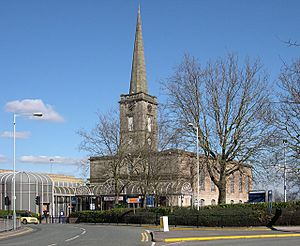St John's Church, Wolverhampton facts for kids
Quick facts for kids St. John's Church, Wolverhampton |
|
|---|---|

The Church of St. John in the Square, Wolverhampton
|
|
| OS grid reference | SO 91426 98162 |
| Location | Wolverhampton |
| Country | England |
| Denomination | Church of England |
| Website | St John's in the Square at Parish of Central Wolverhampton website. Wolverhampton S.John at a Church Near You. |
| History | |
| Dedication | St John the Evangelist |
| Architecture | |
| Heritage designation | Grade II* listed |
| Groundbreaking | 1758 |
| Completed | 1776 |
| Administration | |
| Parish | Central Wolverhampton |
| Deanery | Wolverhampton |
| Archdeaconry | Walsall |
| Diocese | Diocese of Lichfield |
St. John's Church is an important Church of England parish church located in Wolverhampton, England. It is recognized as a Grade II* listed building, meaning it is a particularly important building of more than special interest.
Contents
History of St. John's Church
St. John's Church was built between 1758 and 1776. It was designed by either William Baker or Roger Eykyn. The church was needed because the population of Wolverhampton was growing very fast during the Industrial Revolution. Also, there were concerns about other religious groups becoming more popular in the area.
Why a New Church Was Needed
At that time, the main church in Wolverhampton was St Peter's Collegiate Church. It was a "Royal Peculiar," which meant it was independent from the local Diocese of Lichfield. The leaders of St. Peter's, called deans and a chapter, had control over a large area. They often lived far away and did not want anyone to challenge their power or their income from things like burials and church seating.
However, the town's population was booming due to new factories. Different Christian groups, like Methodism, were also growing. John Wesley, a famous Methodist leader, even preached in Wolverhampton in 1761. There were also many Catholic families in the nearby countryside.
To address these changes, the church leaders eventually agreed to build new churches. St. John's was one of these new churches. It was built as a "chapel of ease," which meant it was a smaller church meant to help the main church serve the growing population.
Building St. John's Church
The building of St. John's was approved by an act of Parliament in 1755. The beautiful Neo-Classical church quickly rose on a site that was then on the southern edge of Wolverhampton.
Initially, St. John's helped ease the crowded conditions at St. Peter's. But the population kept growing, so two more churches were built near St. John's within a few decades. One of these, St. Paul's, was taken down in 1960. Another, St. George's, was turned into a supermarket in the 1980s.
Becoming an Independent Parish
For a long time, St. John's and the other new churches were still dependent on St. Peter's. However, St. Peter's was seen by many as old-fashioned and not very efficient.
In the 1830s, there was a lot of disagreement between the churches. A big change happened in the 1840s when new laws were passed. These laws aimed to modernize the church system. In 1846, the leader of St. Peter's died, and the old system was officially ended.
By 1848, the ancient College of St. Peter was completely abolished. St. John's and the other chapels of ease became independent parish churches within the Diocese of Lichfield. This also meant their clergy (ministers) received better pay. St. John's continued as its own parish church until the late 20th century. Due to changes in population and money issues, it then became part of the Central Wolverhampton Parish.
The Organ at St. John's
St. John's Church has a very old and special organ. It was originally built in 1684 by Renatus Harris. This organ was likely made for a famous "battle of the organs" at Temple Church in London. When it wasn't chosen there, it was sold to Christ Church Cathedral, Dublin.
In 1762, St. John's Church bought the organ from Dublin. Since then, it has been rebuilt and restored many times to keep it working well. You can find more details about this historic organ on the National Pipe Organ Register.
Organists of St. John's
Many talented musicians have served as organists at St. John's Church over the years. Here are some of them:
- William Rudge (until 1843)
- Mr. Day (from 1843)
- Mr. Allen (1856–1862)
- Roland Rogers (1863–1867) – He later became the organist at Bangor Cathedral.
- Dr. Charles Swinnerton Heap (from 1868)
- Herbert Walter Wareing (1876–1879)
- George Halford (1881-1886)
- John Barker (1968–1980)
- Hugh Smith (1980–present)


